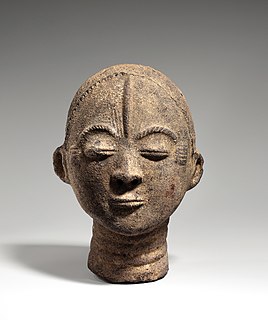 W
WThe Big Fish is a printed ceramic mosaic sculpture by John Kindness. The 10-metre-long (33 ft) statue was constructed in 1999 and installed on Donegall Quay in Belfast, Northern Ireland, near the Lagan Lookout and Custom House.
 W
WThe El-Amra clay model of cattle is a small ceramic sculpture dating from the Predynastic, Naqada I period in Ancient Egypt, at around 3500 BC. It is one of several models found in graves at El-Amra in Egypt, and is now in the British Museum in London. The model is 8.2 centimetres high, 24.2 cm long and 15.3 cm wide. The model was made from clay, and fired at a low temperature before it was painted, however most of the paint is lost.
 W
WThe Haniwa are terracotta clay figures that were made for ritual use and buried with the dead as funerary objects during the Kofun period of the history of Japan. Haniwa were created according to the wazumi technique, in which mounds of coiled clay were built up to shape the figure, layer by layer.
 W
WHanoi Ceramic Mosaic Mural, or Hanoi Ceramic Road, is a ceramic mosaic mural along the walls of the Red River dike system in the city of Hanoi, northern Vietnam.
 W
WThe Memorial Head or Nsodie is a type of 17th to 18th century ceramic portrait sculpture of the Akan peoples, believed to have been created by women artists depicting royal personages. They are represented in the collection of the Metropolitan Museum of Art and elsewhere.
 W
WObjet décoratif carré avec dieux tahitiens is an 1893-1895 terracotta sculpture by Paul Gauguin, now in the Musée d'Orsay, Paris. It depicts Tahitian goddesses on both sides; one the woman is alert and confronting the viewer, on the other the goddess appears to be at rest and sleeping.
 W
WOviri is an 1894 ceramic sculpture by the French artist Paul Gauguin. In Tahitian mythology, Oviri was the goddess of mourning and is shown with long pale hair and wild eyes, smothering a wolf with her feet while clutching a cub in her arms. Art historians have presented multiple interpretations—usually that Gauguin intended it as an epithet to reinforce his self-image as a "civilised savage". Tahitian goddesses of her era had passed from folk memory by 1894, yet Gauguin romanticises the island's past as he reaches towards more ancient sources, including an Assyrian relief of a "master of animals" type, and Majapahit mummies. Other possible influences include preserved skulls from the Marquesas Islands, figures found at Borobudur, and a 9th-century Mahayana Buddhist temple in central Java.
 W
WThe Seated Woman of Çatalhöyük is a baked-clay, nude female form, seated between feline-headed arm-rests. It is generally thought to depict a corpulent and fertile Mother goddess in the process of giving birth while seated on her throne, which has two hand rests in the form of feline heads in a Mistress of Animals motif. The statuette, one of several iconographically similar ones found at the site, is associated to other corpulent prehistoric goddess figures, of which the most famous is the Venus of Willendorf.
 W
WStaffordshire figures are a type of popular pottery figurine made in England from the 18th century onward. Most Staffordshire figures made from 1740 to 1900 were produced by small potteries and makers' marks are generally absent. Most Victorian figures were designed to stand on a shelf or mantlepiece and are therefore only modelled and decorated where visible from the front and sides. These are known as 'flatbacks'.
 W
WThe Venus of Dolní Věstonice is a Venus figurine, a ceramic statuette of a nude female figure dated to 29,000–25,000 BCE. It was found at the Paleolithic site Dolní Věstonice in the Moravian basin south of Brno, in the base of Děvín Mountain, 549 metres (1,801 ft). This figurine and a few others from locations nearby are the oldest known ceramic articles in the world.
 W
W"William", also known as "William the Hippo", is an Egyptian faience hippopotamus statuette from the Middle Kingdom, now in the collection of the Metropolitan Museum of Art in New York City, where it serves as an informal mascot of the museum. Found in a shaft associated with the Upper Egyptian tomb chapel of "The Steward, Senbi", in what is now Meir, William dates from c. 1961 BC – c. 1878 BC, during the reigns of Senusret I and Senusret II. This 20 cm figurine in Egyptian faience, a clay-less material, has become popular not only for his endearing appearance, but also because his defining characteristics illustrate many of the most salient facets of craft production in ancient Egypt during this time.
 W
WXochipala is a minor archaeological site in the Mexican state of Guerrero, whose name has become attached, somewhat erroneously, to a style of Formative Period figurines and pottery from 1500 to 200 BCE. The archaeological site belongs to the Classic and Postclassic eras, from 200-1400 CE.